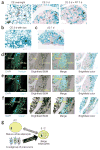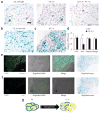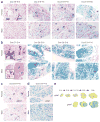Tracking adipogenesis during white adipose tissue development, expansion and regeneration
- PMID: 23995282
- PMCID: PMC4075943
- DOI: 10.1038/nm.3324
Tracking adipogenesis during white adipose tissue development, expansion and regeneration
Abstract
White adipose tissue displays high plasticity. We developed a system for the inducible, permanent labeling of mature adipocytes that we called the AdipoChaser mouse. We monitored adipogenesis during development, high-fat diet (HFD) feeding and cold exposure. During cold-induced 'browning' of subcutaneous fat, most 'beige' adipocytes stem from de novo-differentiated adipocytes. During HFD feeding, epididymal fat initiates adipogenesis after 4 weeks, whereas subcutaneous fat undergoes hypertrophy for a period of up to 12 weeks. Gonadal fat develops postnatally, whereas subcutaneous fat develops between embryonic days 14 and 18. Our results highlight the extensive differences in adipogenic potential in various fat depots.
Figures





References
Publication types
MeSH terms
Substances
Grants and funding
LinkOut - more resources
Full Text Sources
Other Literature Sources
Molecular Biology Databases

